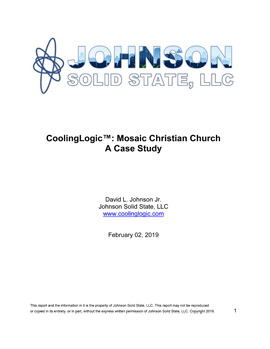A brief summary of some aspects of the CoolingLogic™ technology. CoolingLogic™ incorporates methods of operating Heating, Ventilation and Air Conditioning (HVAC) systems, that can be compared to artificial intelligence for HVAC systems. It is our hope that this brief summary will provide a quick and easy overview of some of the sophisticated and mathematically complex algorithms and processes that make up CoolingLogic™.
It’s important to note that while this summary focuses on certain aspects of the CoolingLogic™ technologies, it certainly does not cover all aspects of the technologies.
A brief summary of CoolingLogic™ may be viewed by clicking on this link.
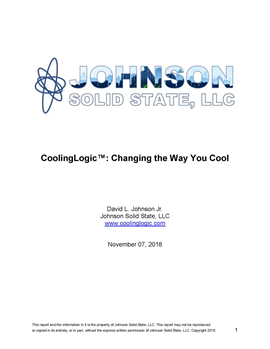
The unscripted and narrated CoolingLogic™ video provides engineers with a brief overview of CoolingLogic™. The presentation is simply an overview, and is not intended to replace the other CoolingLogic™ documents, but rather to compliment those documents by providing salient information about CoolingLogic™. Because it seems like we’ve been moving 1,000 miles per hour with our work, and because there has been so much to do lately, we didn’t script the presentation, besides what is written on the slides. Such as this is the case, there may be some minor mistakes and the presentation may be a little slow-going, however, we are very proud of how this presentation turned out, in general. There are two different quality presentations, which both have the same content.
The higher quality presentation may be played by clicking on this link.
The lower quality presentation may be played by clicking on this link.
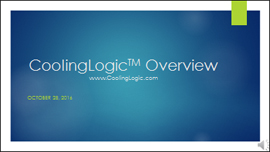
The CoolingLogic™ White Paper provides in-depth engineering and market calculations, considerations and analysis. We know the value of CoolingLogic™. The white paper was written to express and mathematically prove that value to those who are engineers and/or are in the HVAC industry. Click on the link or the image to view the CoolingLogic™ White Paper!.
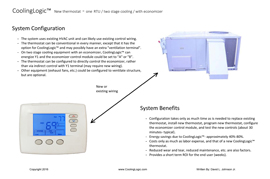
The Continuance In Part (CIP) filed with the USPTO is pretty amazing; however, it's not exactly easy to understand. To understand the relevance of the CIP, one needs to give careful consideration to the White Paper (above) and be expert at both physics and thermal dynamics. Some engineers take days to understand the relevance of certain variables in the disclosure. Click on the link or the image to view First CIP of CoolingLogic™.

As of 09-17-22 we have patents pending in the USA, the European Union, and inCanada.
Here are some already issued patents:
Patent #: US 9,447,985 B2.
Patent #: CA3043996A1
Patent #: US 10,871,756 B2
Patent #: US 10,908,578 B2
Patent #: US 10,921,768 B2
Patent #: US 11,156,978 B2
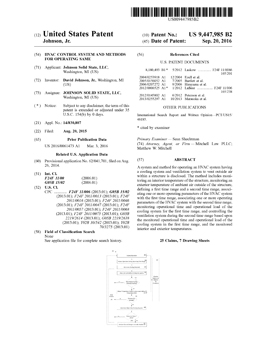
Immediately following the filing date of our first CIP, we undertook significant efforts to sell our IP, which included sending out large packages of information via certified mail. Included in each of the packages was:
- a letter addressed to a specific person at the respective company (usually the C.E.O.),
- a printed copy of Patent #: US 9,447,985 B2!
- a printed copy of the "First CIP of CoolingLogic™”, which was first published on this website (after it was filed with the USPTO). Later it was published as
USPTO publication # US20160348936A1
on 12-01-2016),
- a One page Flier, and
- a printed copy of " CoolingLogic™ White Paper!" dated September 24, 2016 and also published on the website www.CoolingLogic.com around the same time.
This document is a non-inclusive file containing letters and signature receipts for some of the packages sent during the 2016 campaign to license and/or sell our IP. We’ve noticed that there have been patent applications filed and granted, on subject matter completely taught by the disclosures that we made, and what is more is that it is often by the organizations to which we sent those packages. The companies and files are in alphabetical order.
Click on the link or the image to view Certified Mail Sent to Various Companies, etc. in 2016.
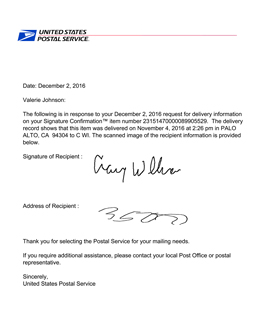
Dated February 02, 2019, the case study for Mosaic Christian Church covers work performed from at least 12-20-15, until the date of the actual case-study. The calculations seem to show that about 200 SEER was achieved.
Short Version.
Long Version.
